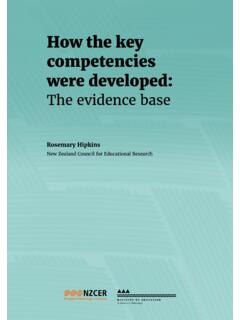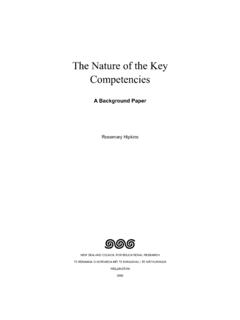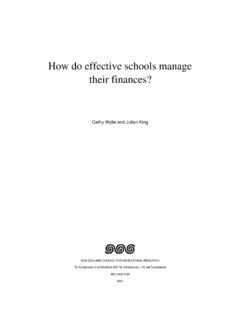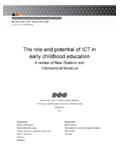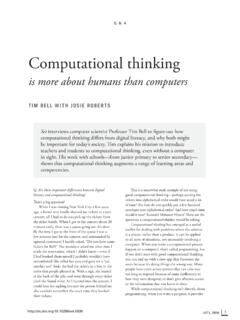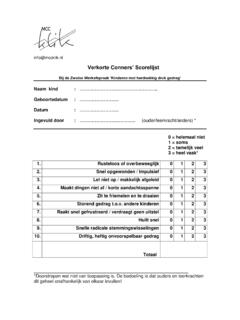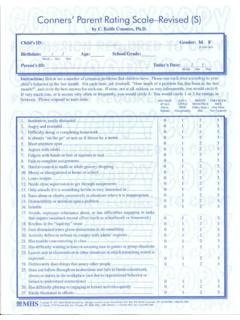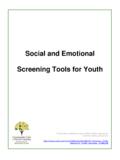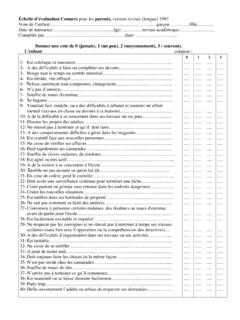Transcription of Conners 3–Teacher Assessment Report - NZCER
1 Conners 3 TeacherBy C. Keith Conners , 2008 Multi-Health Systems Inc. All rights Box 950, North Tonawanda, NY 14120-09503770 Victoria Park Ave., Toronto, ON M2H 3M6 This Assessment Report is intended for use by qualified assessors only, and is not to be shown or presentedto the respondent or any other unqualified Reportver. 1 SAMPLES ummary of ResultsResponse Style AnalysisScores on the Validity scales do not indicate a positive, negative or inconsistent response of Elevated ScoresThe following section summarizes areas of concern for Susan S based on her teacher s ratings on the Conners 3-T. Note that areas that are not a concern are not reported in this 3-T Content ScalesThe T-scores for the following Conners 3-T Content scales were very elevated ( , T-score 70), indicating many more concerns than are typically reported: Inattention (T = 85) and Hyperactivity/Impulsivity (T = 90).
2 The T-scores for the following Conners 3-T Content scales were elevated ( , T-score = 65 to 69), indicating more concerns than are typically reported: Executive Functioning (subscale) (T = 69) and Defiance/Aggression (T = 67).DSM-IV-TR Symptom ScalesThe Symptom Counts were probably met and the T-scores were elevated or very elevated ( , T-score 65) for the following DSM-IV-TR Symptom scales: ADHD Predominantly Inattentive Type (T = 82) and ADHD Predominantly Hyperactive-Impulsive Type (T = 90). These diagnoses should be given strong consideration. The Symptom Count was probably not met; however, the T-score was elevated or very elevated ( , T-score 65) for the following DSM-IV-TR Symptom scale: Oppositional Defiant Disorder (T = 84).
3 Although the current presentation is atypical for 8-year-old girls, there are insufficient symptoms reported to meet DSM-IV-TR symptomatic criteria for this disorder. Consider alternative explanations for why the T-score could be elevated in the absence of this diagnosis ( , another diagnosis may be producing these types of concerns in that particular setting).ImpairmentThe teacher reports that Susan S s problems seriously affect her functioning very frequently (rating = 3) in the academic setting, and occasionally (rating = 1) in the social 3 Index ScoresScreener ItemsBased on the teacher s ratings, further investigation was suggested/recommended for issues with on the teacher s ratings, an ADHD classification is strongly indicated (96% probability), but other clinically relevant information should also be carefully considered in the Assessment process.
4 The T-scores for the following Conners 3 Global Index scales were very elevated ( , T-score 70), indicating many more concerns than are typically reported: Conners 3GI: Restless-Impulsive (T = 90), Conners 3GI: Emotional Lability (T = 72) and Conners 3GI: Total (T = 90). Conners 3-T Results and IDEAS cores on the Conners 3-T suggest possible consideration for IDEA 2004 eligibility in the following area(s):Developmental Delay-Emotional, Emotional Disturbance, Other Health Impairment and Specific 3 T Assessment Report for Susan SAdmin Date: 09/29/2006 Page 2 Copyright 2008 Multi-Health Systems Inc. All rights 1 SAMPLEC onners 3 T Assessment Report for Susan SAdmin Date: 09/29/2006 Cautionary RemarkThis Summary of Results section only provides information about areas that are a concern.
5 Please refer to the remainder of the Assessment Report for further information regarding areas that are not elevated or could not be scored due to omitted 3 Copyright 2008 Multi-Health Systems Inc. All rights 1 SAMPLEC onners 3 T Assessment Report for Susan SAdmin Date: 09/29/2006 IntroductionThe following section provides the teacher s scores for the Positive and Negative Impression scales and theInconsistency Style AnalysisThe Positive Impression score (raw score = 0) does not indicate an overly positive response ImpressionThe Negative Impression score (raw score = 1) does not indicate an overly negative response ImpressionThe Inconsistency Index score (raw score = 3, number of differentials 2 = 0) does not indicate aninconsistent response IndexThe Conners 3rd Edition- teacher ( Conners 3 T) is an Assessment tool used to obtain the teacher s observations about his/her student's behavior in a school setting.
6 This instrument is designed to assess Attention Deficit/Hyperactivity Disorder (ADHD) and its most common co-morbid problems in children and adolescents aged 6 to 18 years old. When used in combination with other information, results from the Conners 3 T can provide valuable information to guide Assessment decisions. This Report provides information about the teacher 's Assessment of the youth, how she compares to other youth, and which scales and subscales are elevated. See the Conners 3 Manual (published by MHS) for more information. This computerized Report is an interpretive aid and should not be provided to teachers or used as the sole criterion for clinical diagnosis or intervention. Administrators are cautioned against drawing unsupported interpretations.
7 Combining information from this Report with information gathered from other psychometric measures, interviews, observations, and review of available records will give the assessor or service provider a more comprehensive view of the youth than might be obtained from any one source. This Report is based on an algorithm that produces the most common interpretations for the scores that have been obtained. Administrators should review the teacher s responses to specific items to ensure that these typical interpretations apply to the youth being described. Page 4 Copyright 2008 Multi-Health Systems Inc. All rights 1 SAMPLEC onners 3 T Assessment Report for Susan SAdmin Date: 09/29/2006 The following graph provides T-scores for each of the Conners 3 T Content scales and subscales.
8 The error bars on each bar represent Standard Error of Measurement (SEM) for each scale score. For information on SEM, see the Conners 3 Manual. Conners 3 T Content Scales: T-scoresPage 5 Copyright 2008 Multi-Health Systems Inc. All rights 1 SAMPLEC onners 3 T Assessment Report for Susan SAdmin Date: 09/29/2006 Conners 3 T Content Scales: Detailed ScoresThe following table summarizes the results of the teacher s Assessment of Susan S and provides general information about how she compares to the normative group. Please refer to the Conners 3 Manual for more information on the interpretation of these results. Common Characteristics of HighScorersGuidelineRawScoreScaleT-score SEM(Percentile)Very Elevated Score (Manymore concerns than are typicallyreported)85 (99)28 InattentionMay have poor concentration/attention ordifficulty keeping his/her mind on make careless mistakes.
9 May beeasily distracted. May give up easily or beeasily bored. May avoid Elevated Score (Manymore concerns than are typicallyreported)90 (99)43 Hyperactivity/ImpulsivityHigh activity levels, may be restlessand/or impulsive. May have difficulty beingquiet. May interrupt others. May be Score (Typical levels ofconcern)59 (84)19 LearningProblems/ ExecutiveFunctioning (LE):TotalAcademic struggles. May have difficultylearning and/or remembering need extra instructions. May haveexecutive Score (Typical levels ofconcern)47 (53)2 LearningProblems (LE subscale)Struggles with reading, spelling, and/ormath. May have difficulty Score (More concernsthan are typically reported)69 (89)14 ExecutiveFunctioning (LE subscale)May have difficulty starting or finishingprojects, may complete projects at the lastminute.
10 May have poor planning,prioritizing, or organizational Score (More concernsthan are typically reported)67 (92)6 Defiance/AggressionMay be argumentative; may defy requestsfrom adults; may have poor control ofanger or may lose temper; may bephysically and/or verbally aggressive; mayshow violent or destructive tendencies;may bully others; may be manipulative orcruel. May have legal Score (Typical levels ofconcern)58 (82)4 Peer RelationsMay have difficulty with friendships, poorsocial skills, limited social skills. Mayappear to be unaccepted by : SEM = Standard Error of MeasurementPage 6 Copyright 2008 Multi-Health Systems Inc. All rights 1 SAMPLEC onners 3 T Assessment Report for Susan SAdmin Date: 09/29/2006 DSM-IV-TR OverviewThis section of the Report provides the following information for each DSM-IV-TR diagnosis on the Conners 3 T: 1.

